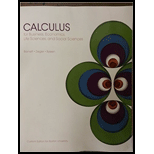
Concept explainers
Convert to radian measure in terms of π:
(A) 30° (B) 45° (C) 60° (D) 90°
(A)
To find: The radian measure of
Answer to Problem 1RE
The radian measure for
Explanation of Solution
Formula used:
Degree-radian conversion:
Calculation:
It is given that
Substitute the value of
Therefore, the radian measure for
(B)
To find: The radian measure of
Answer to Problem 1RE
The radian measure for
Explanation of Solution
It is given that
Substitute the value of
Therefore, the radian measure for
(C)
To find: The radian measure of
Answer to Problem 1RE
The radian measure for
Explanation of Solution
It is given that
Substitute the value of
Therefore, the radian measure for
(D)
To find: The radian measure of
Answer to Problem 1RE
The radian measure for
Explanation of Solution
It is given that
Substitute the value of
Therefore, the radian measure for
Want to see more full solutions like this?
Chapter 8 Solutions
Calculus for Business, Economics, Life Sciences, and Social Sciences - Boston U.
- A research team consists of 4 senior researchers and 10 research assistants. The team needs to select 2 senior researchers and 2 research assistants to attend a conference. How many different ways can the group being sent to the conference be formed?arrow_forwardThere are 25 different varieties of flowering plants found in a natural habitat you are studying. You are asked to randomly select 5 of these flowering plant varieties to bring back to your laboratory for further study. How many different combinations of are possible? That is, how many possible 5 plant subgroups can be formed out of the 25 total plants found?arrow_forwardA person is tossing a fair, two-sided coin three times and recording the results (either a Heads, H, or a Tails, T). Let E be the event that exactly two heads are tossed. Which of the following sets represent the event E? Group of answer choices {HHT, HTH, THH} {HHT, THH} {HHH, HHT, HTH, THH, TTT, TTH, THT, HTT} {HH}arrow_forward
- Take Quiz 54m Exit Let the universal set be whole numbers 1 through 20 inclusive. That is, U = {1, 2, 3, 4, . . ., 19, 20}. Let A, B, and C be subsets of U. Let A be the set of all prime numbers: A = {2, 3, 5, 7, 11, 13, 17, 19} Let B be the set of all odd numbers: B = {1,3,5,7, • • , 17, 19} Let C be the set of all square numbers: C = {1,4,9,16} ☐ Question 2 3 pts Which of the following statement(s) is true? Select all that apply. (1) АСВ (2) A and C are disjoint (mutually exclusive) sets. (3) |B| = n(B) = 10 (4) All of the elements in AC are even numbers. ☐ Statement 1 is true. Statement 2 is true. Statement 3 is true. Statement 4 is true.arrow_forward☐ Question 1 2 pts Let G be the set that represents all whole numbers between 5 and 12 exclusive. Which of the following is set G in standard set notation. (Roster Method)? O G = [5, 12] G = {5, 6, 7, 8, 9, 10, 11, 12} O G = (5, 12) OG = {6, 7, 8, 9, 10, 11}arrow_forwardSolve 11.23arrow_forward
 Mathematics For Machine TechnologyAdvanced MathISBN:9781337798310Author:Peterson, John.Publisher:Cengage Learning,
Mathematics For Machine TechnologyAdvanced MathISBN:9781337798310Author:Peterson, John.Publisher:Cengage Learning,
